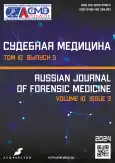Незрелость соединительной ткани как причина повреждения твёрдой мозговой оболочки у новорождённых с экстремально низкой массой тела
- Авторы: Горун Е.Ю.1, Парилов С.Л.1, Максимов А.В.1,2
-
Учреждения:
- Московский областной научно-исследовательский клинический институт имени М.Ф. Владимирского
- Государственный университет просвещения
- Выпуск: Том 10, № 3 (2024)
- Страницы: 363-371
- Раздел: Оригинальные исследования
- URL: https://bakhtiniada.ru/2411-8729/article/view/267495
- DOI: https://doi.org/10.17816/fm16165
- ID: 267495
Цитировать
Аннотация
Обоснование. Глубокая недоношенность является ведущим фактором повреждения нервной системы в родах. В статье представлен анализ случаев родовых повреждений у новорождённых с экстремально низкой массой тела с изучением особенностей строения твёрдой мозговой оболочки, а также сравнение полученных результатов с показателями доношенных новорождённых.
Цель исследования ― выявить отличительные особенности строения соединительной ткани твёрдой мозговой оболочки у новорождённых с экстремально низкой массой тела и доношенных новорождённых; установить наличие связи между особенностями строения твёрдой мозговой оболочки и её повреждением во время родов.
Материалы и методы. Проведено ретроспективное выборочное исследование. Основную группу составили новорождённые с экстремально низкой массой тела, группу сравнения ― доношенные новорождённые с установленным фактом родовой травмы. В обеих группах изучалась твёрдая мозговая оболочка из области парусов мозжечкового намёта, серпа и стока пазух; проводилось их сравнение с подсчётом коллагеновых волокон I типа методами световой и поляризационной микроскопии, морфометрии. Оценивались причины преждевременных родов в основной группе, характер кровоизлияний в твёрдую мозговую оболочку.
Результаты. У новорождённых с экстремально низкой массой тела в твёрдой мозговой оболочке обнаружены выраженные интрадуральные кровоизлияния, свидетельствующие о её перерастяжении вследствие конфигурации головы, с незначительными кровоизлияниями в мягкой мозговой оболочке. Твёрдая мозговая оболочка в основной группе представлена рыхлой соединительной тканью, состоящей преимущественно из коротких волокон коллагена III типа, с отсутствием анизотропии. В группе сравнения выраженность субарахноидальных кровоизлияний в проекции швов соответствует выраженности повреждений перегородочных частей твёрдой мозговой оболочки. Твёрдая мозговая оболочка состоит из плотной волокнистой соединительной ткани и преимущественно коллагена I типа с чётким поляризационным эффектом.
При морфометрии анизотропия в поляризованном свете в основной группе выявлена не более чем в 2–5% коллагеновых волокон, в группе сравнения ― не менее чем в 30–50%.
Заключение. Особенности строения свидетельствуют о морфофункциональной незрелости соединительной ткани твёрдой мозговой оболочки у новорождённых с экстремально низкой массой тела, что отражается на её прочностных характеристиках и приводит к повреждениям при любом виде родов. Следовательно, данная травма является травмой болезненно изменённого органа, поэтому не квалифицируется по тяжести вреда здоровью.
Ключевые слова
Полный текст
Открыть статью на сайте журналаОб авторах
Екатерина Юрьевна Горун
Московский областной научно-исследовательский клинический институт имени М.Ф. Владимирского
Автор, ответственный за переписку.
Email: katuhka30@mail.ru
ORCID iD: 0000-0002-7008-2975
SPIN-код: 4298-5402
Россия, Москва
Сергей Леонидович Парилов
Московский областной научно-исследовательский клинический институт имени М.Ф. Владимирского
Email: parilov.s@mail.ru
ORCID iD: 0000-0001-9888-4534
SPIN-код: 1764-7532
д-р мед. наук, доцент
Россия, МоскваАлександр Викторович Максимов
Московский областной научно-исследовательский клинический институт имени М.Ф. Владимирского; Государственный университет просвещения
Email: mcsim2002@mail.ru
ORCID iD: 0000-0003-1936-4448
SPIN-код: 3134-8457
д-р мед. наук, доцент
Россия, Москва; МоскваСписок литературы
- Goldenberg R.L. The management of preterm labor // Obstetrics Gynecology. 2002. Vol. 100, N 5, Pt. 1. P. 1020–1037. doi: 10.1016/s0029-7844(02)02212-3
- Дускалиев Д.А., Хвиль Ю.В. Анализ данных аутопсий детей с экстремально низкой массой тела и очень низкой массой тела // Forcipe. 2020. Т. 3, № S1. С. 644–645. EDN: CVBXCU
- Boyle A.K., Rinaldi S.F., Norman J.E., Stock S.J. Preterm birth: Inflammation, fetal injury and treatment strategies // J Rep Immunol. 2017. N 119. P. 62–66. EDN: VZOVMT doi: 10.1016/j.jri.2016.11.008
- Соколовская Т.А., Ступак В.С., Сон И.М., и др. Недоношенный дети с экстремально низкой массой тела: динамика заболеваемости и смертности в Российской Федерации // Дальневосточный медицинский журнал. 2020. № 3. С. 119–123. EDN: PNLZIG doi: 10.35177/1994-5191-2020-3-119-123
- Жевнеронок И.В., Шалькевич Л.В., Лунь А.В. Современные представления о механизмах формирования перивентрикулярной лейкомаляции у недоношенных новорожденных // Репродуктивное здоровье. Восточная Европа. 2020. Т. 10, № 3. С. 350–356. EDN: MNVMUG doi: 10.34883/PI.2020.10.3.013
- Козлов Ю.А., Капуллер В.М. Родовая травма органов брюшной полости и забрюшинного пространства у новорожденных детей // Педиатрия. Журнал им. Г.Н. Сперанского. 2020. Т. 99, № 5. С. 175–184. EDN: MMIRUR doi: 10.24110/0031-403X-2020-99-5-175-184
- Глухов Б.М., Булекбаева Ш.А., Байдарбекова А.К. Этиопатогенетические характеристики внутрижелудочковых кровоизлияний в структуре перинатальных поражений мозга: обзор литературы и результаты собственных исследований // Русский журнал детской неврологии. 2017. № 2. С. 21–33. EDN: ZBTNCT doi: 10.17650/2073-8803-2017-12-2-21-33
- Кравченко Е.Н. Факторы риска интранатальных повреждений плода // Фундаментальная и клиническая медицина. 2018. Т. 3, № 3. С. 54–58. EDN: YKWQDR
- Милованова О.А., Амирханова Д.Ю., Миронова А.К., и др. Риски формирования неврологической патологии у глубоконедоношенных детей: обзор литературы и клинические случаи // Медицинский совет. 2021. № 1. С. 20–29. EDN: CIFVUB doi: 10.21518/2079-701X-2021-1-20-29
- Donn S.M., Chiswick M.L., Fanaroff J.M. Medico-legal implications of hypoxic: Ischemic birth injury // Seminars Fetal Neonatal Medicine. 2014. Vol. 19, N 5. Р. 317–321. doi: 10.1016/j.siny.2014.08.005
- De Sévaux J.L., Nikkels P.G., Lequin M.H., Groenendaal F. The value of autopsy in neonates in the 21st century // Neonatology. 2019. Vol. 115, N 1. P. 89–93. doi: 10.1159/000493003
- Бубнова Н.И., Парилов С.Л., Цхай В.Б. Родовая черепно-мозговая травма новорожденных ― вина акушера или несчастный случай? // Сибирское медицинское обозрение. 2009. № 3. С. 114–115.
- Судебная медицина: национальное руководство / под ред. Ю.И. Пиголкина. 2-е изд., перераб. и доп. Москва: ГЭОТАР-Медиа, 2021. 672 с.
- Парилов С.Л. Родовая травма нервной системы у детей. Монография. 2018. Режим доступа: https://oa.mg/work/2963831840. Дата обращения: 15.04.2024.
- Новая медицинская технология АА 0001104. ФС № 2011/169. 15.06.2011. Судебно-медицинская дифференциальная диагностика родовой травмы нервной системы от травмы насильственного происхождения. Режим доступа: https://www.rc-sme.ru/Publishing/BookCatalog/index.php?ELEMENT_ID=1560. Дата обращения: 15.06.2024.
- Кузнецов С.Л., Мушкамбаров Н.Н. Гистология, цитология и эмбриология: учебник. 3-е изд., испр. и доп. Москва: Медицинское информационное агентство, 2016. 640 с.
Дополнительные файлы










